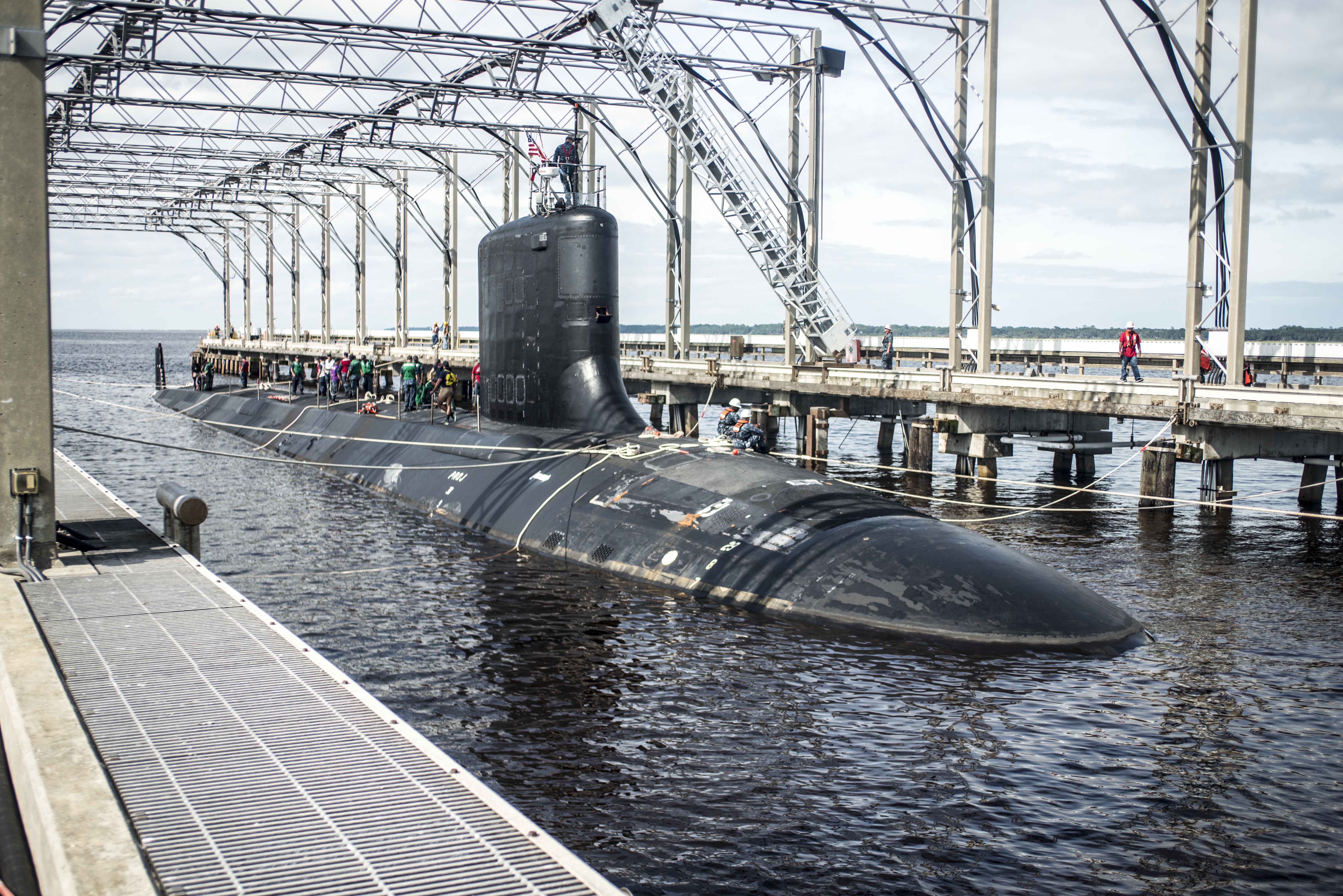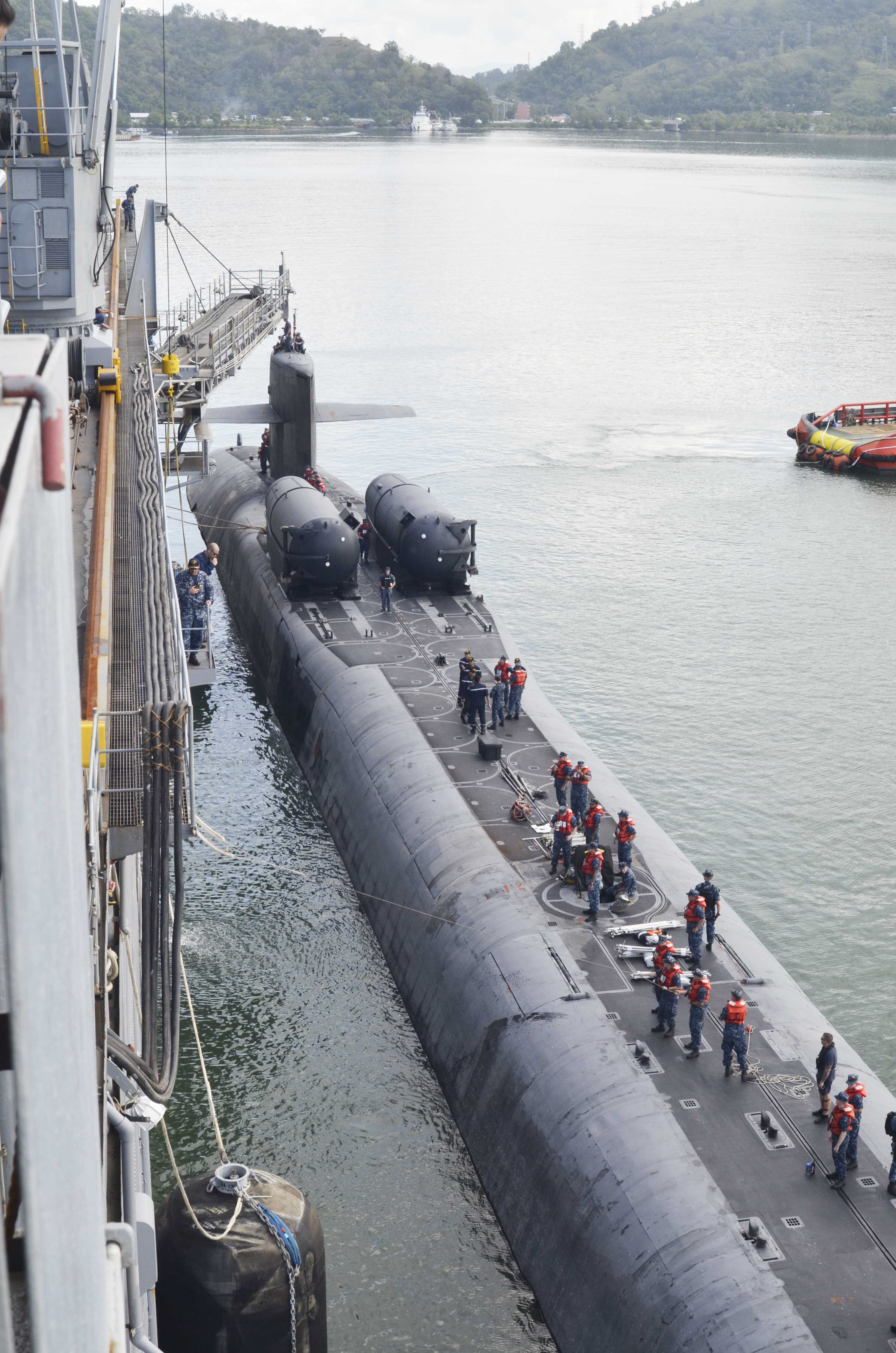
The Navy has developed a Tactical Submarine Evolution Plan that looks at rapidly inserting capability upgrades into the Virginia-class attack submarine mid-contract and considers long-term undersea warfare priorities such as converting the Columbia-class ballistic missile submarine (SSBN) production line into a guided-missile submarine (SSGN) line in the late 2030s.
The Navy’s Undersea Warfare Directorate (OPNAV N97) started the plan under previous director Vice Adm. Bill Merz, who now serves as the deputy chief of naval operations for warfare systems (OPNAV N9), and has been continued under current acting director Brian Howes.
Howes, speaking Thursday at the Naval Submarine League’s annual symposium, said the next iteration of the Virginia-class submarine program, Block V, begins in Fiscal Year 2019, but currently if a new capability were developed after the design is complete, it would have to wait to be fielded in the next Block VI in FY 2023.
“We need to have the opportunity to have mid-block insertions into our platforms,” he said.
Much like the Submarine Warfare Federated Tactical Systems that inserts combat upgrades into submarines every other year, Howes said the Tactical Submarine Evolution Plan (TSEP) would create “a ready menu of mature and maturing technology that we will insert when ready.”
Though headed by OPNAV N97, the Program Executive Office for Submarines and the Virginia class program office are involved and wholeheartedly onboard.
“There’s a continuous conveyor belt running, and developers who have an idea get on that conveyor belt, and if they can develop it and achieve the requisite reliability and producibility by the time that conveyor belt comes around for production then they can get into the next version … that’s going to be fielded. If they miss that one, then the conveyor belt goes back around again and they get another shot at it in two years,” PEO Subs Rear Adm. Michael Jabaley said at the conference of SWFTS and the Acoustics Rapid Commercial-off-the-shelf Insertion (ARCI) program that does the same thing on the computer processor side.
“So we want to try to implement that into shipbuilding. The time sequence is different of course – we’re somewhat constrained by five-year multiyear procurement contracts, and we have previously tried to hold to a tech baseline letter at the beginning of the block that says the most efficient way to build 10 ships, all per this plan. One of the things that the TSEP looks at is, under the [chief of naval operations]’s theme of getting faster, waiting five years to insert the next technological development may not be the best thing for us to do. So we’re willing to take risk, we’re willing to look at breakthrough technologies that come, and if it makes sense to insert them mid-block then we’re willing.”
This concept somewhat blurs the lines of future Blocks VI and VII and the eventual move to the SSN(X) attack sub program. The Virginia class has been upgraded in each block to improve manufacturing, reduce lifecycle costs, and add a mid-body Virginia Payload Module with additional missile tubes. Though two more iterations of upgrades are planned, the submarine community is finding they’re running out of space to add more capability.
“We are running out of design margin in this great platform, and there are some fleet needs which this platform cannot do. So as a result, under Adm. Merz’s leadership, we’ve started the discussion of how we’re going to leverage our block improvement conveyor belt to wring out as much as we can for future blocks of Virginia, while setting us up for success after Virginia,” Howes said. TSEP would identify “capabilities that we are going to demand our shipbuilders inject into this platform, and if it can’t be injected into this platform we’re going to design it into [SSN(X)].”
Jabaley said the Virginia program had already had its acquisition program baseline extended from 30 boats to the current 48, which the program is scheduled to reach in FY 2033 – but will likely hit even sooner, as the Navy looks at speeding up Virginia-class submarine construction.
“Then we’ll make the decision, do we extend the APB again or will it be time to move on to a future submarine design?” Jabaley said. Though old assumptions point to moving to SSN(X) in FY 2034, as TSEP inserts more capability upgrades into the subs at a faster pace, “if technology, threat, environment, budget all conspire to say it makes more sense to start it earlier, start it later, then that’s what we’ll do.”
Howes told USNI News that “there is a need for a dedicated funding line to support this conveyor belt, and we are in discussions inside the Navy and with [the Office of the Secretary of Defense] as to what that would look like. Ideally, first we’d get those resources from within, through cost-savings. One way or another we’re going to start this up – the design effort, the technology development, it gets faster with resources; there is a need for resources and we are having those discussions today as part of our [FY 2019 budget] deliberations.”
The TSEP doesn’t just look at adding the capability to the Virginia-class subs and its successor SSN(X). It also looks at the SSGN concept: the fleet’s four SSGNs are set to decommission by 2028, and while the Virginia Payload Module and its extra missile tubes are meant to mitigate the loss, they don’t make up for the full strike capability – nor the special operations forces support – the fleet will lose at the end of the SSGNs’ life.

To address that firepower gap, the TSEP looks at the possibility of using the Columbia-class SSBN design and production line to flow into an SSGN production line in the mid-2030s. General Dynamics’ Electric Boat and Huntington Ingalls’ Newport News Shipbuilding will build a dozen SSBNs – one in 2021, one in 2024, and then one a year in 2026 through 2035 – and talks are underway about keeping that production line warm by building more guided-missile subs.
“There is value in keeping two product lines going,” Howes said of the large SSBNs and SSGNs and the smaller SSN and SSN(X) attack subs.
“You never want to start up and shut down product lines, so the big-volume ship is one we’re interested in exploring after we complete our buy of Columbia. Conceptually, there is a value in recapitalizing our SSGN ship that is a different mission task, and then if you keep the line warm eventually we’ll have to recapitalize the SSBN line. So then you don’t have to start from scratch, which is what [Electric Boat] and Huntington Ingalls are having to do right now with Columbia because the last Ohio [class SSBN] came out in 1998.”
On top of the TSEP concept, the Navy has also worked on an Alternate Futures Study, Naval Reactors director Adm. Frank Caldwell said Nov. 1 at the conference. The submarine community has worked with the Naval War College to look at future demands on the force, where it might be asked to operate, doing what missions, against which adversaries and with which allies, and more.
“We will use the Alternate Futures Study to inform our decision regarding future capabilities and operational requirements, not only for the next platform but for other investments in the undersea domain,” Caldwell said, noting the study doesn’t point to a single future but rather a range of 2040 potential futures for which the force can plan.





